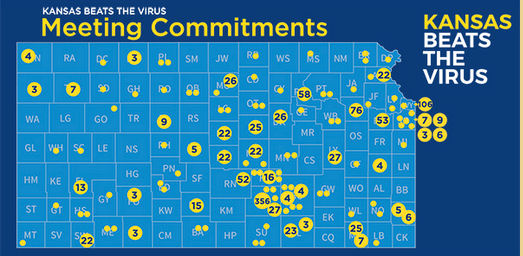An ambitious group of Kansas 4-H members and adult volunteers recently took the bull by its proverbial horns in helping their communities cope with the ongoing grind of the COVID-19 pandemic.
They are helping to lead local discussions on the challenges that people are facing during a time when they are staying at home more, seeing friends less and – in some cases – missing out on family gatherings.
Aliah Mestrovich Seay, a youth development specialist for community vitality, said the 4-H members’ efforts are part of the statewide program, Kansas Beats the Virus, a public health partnership between the Kansas Leadership Center and the State of Kansas.
Throughout December, the Kansas Leadership Center is helping to fund groups to lead community meetings and inspire local solutions to keep Kansans healthy, schools and businesses open, and the economy strong.
The KLC set a goal to host 1,000 community meetings in December. As of the middle of the month, the organization reports 1,150 meeting commitments, and 209 action plans launched in Kansas communities.
In most instances, the KLC provides trained professional facilitators to guide local meetings. In the case of Kansas 4-H, however, the organization is lending a helping hand by providing youth and adult facilitators that have received training through its Community Conversations program.
“I think the KLC thought that was pretty amazing that we have these youth and adults that are trained in positive youth development and know how to facilitate community conversations,” Mestrovich Seay said.
According to Mestrovich Seay, 4-H youth and volunteers will help lead 20 community meetings by the end of December. Some ideas that have come from the conversations include volunteers making goodie bags for essential care workers – “including a handwritten ‘Thank You’ note,” she said – and promoting a social media hashtag encouraging people to stay connected at a distance.
“I think this was the perfect time to do this type of activity because morale is down, people are tired, it’s the holidays, and this is when we typically get to see family and friends, do caroling … (but) we aren’t going to be able to do those in the same way as we’ve done before,” Mestrovich Seay said.
“Youth are able to speak to the fact that they miss their friends, but that they want to stay safe and they want to be leaders in their community to promote healthy living,” she said. “I would say this activity not only created safer local environments, but also boosted morale. They are truly living out their 4-H pledge to pledge their health to better living.”
In some early meetings, Mestrovich Seay said it was “interesting to see first-hand what youth are really thinking about.”
“Some of them expressed worry about the fact that they could be asymptomatic and could carry or spread that to a high-risk family member, or to their grandparents or a very young sibling. To hear them speak so eloquently, in an educated way, about this virus, I was really impressed not only by the background information they had but also how they put their understanding into practice to stay safe and better their community.”
A growing number of 4-H youth continue to receive training in facilitating community conversations around many topics. Persons interested in hosting a conversation led by youth in their area can contact Mestrovich Seay by email, [email protected].



